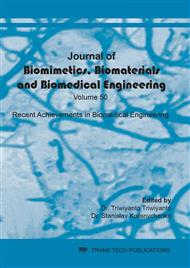[1]
Supas, Profil Penduduk Hasil Supas. (2015).
Google Scholar
[2]
P. Ponpriya and E. Priya, Design and control of prosthetic hand using myoelectric signal,, Proc. 2017 2nd Int. Conf. Comput. Commun. Technol. ICCCT 2017, p.383–387, (2017).
DOI: 10.1109/iccct2.2017.7972314
Google Scholar
[3]
M. D. M. Atique and S. E. Rabbani, A cost-effective myoelectric prosthetic hand,, J. Prosthetics Orthot., vol. 30, no. 4, p.231–235, (2018).
DOI: 10.1097/jpo.0000000000000211
Google Scholar
[4]
Y. Bandou, O. Fukuda, H. Okumura, K. Arai, and N. Bu, Development of a prosthetic hand control system Based on general object recognition analysis of recognition accuracy during approach phase,, ICIIBMS 2017 - 2nd Int. Conf. Intell. Informatics Biomed. Sci., vol. 2018–Janua, p.110–114, (2018).
DOI: 10.1109/iciibms.2017.8279703
Google Scholar
[5]
R. Ahmed, Prosthetic Arm Control Using Electromyography ( EMG ) Signal,, 2018 Int. Conf. Adv. Electr. Electron. Eng., p.1–4, (2018).
Google Scholar
[6]
R. E. Russo et al., Algorithm of Myoelectric Signals Processing for the Control of Prosthetic Robotic Hands,, J. Comput. Sci. Technol., vol. 18, no. 1, p.28–34, (2018).
Google Scholar
[7]
A. V. Vidyapeetham, EMG Controlled Low Cost Prosthetic Arm,, IEEE Distrib. Comput. VLSI, Electr. Circuits Robot., p.169–172, (2016).
Google Scholar
[8]
A. H. Al-Timemy, R. N. Khushaba, G. Bugmann, and J. Escudero, Improving the Performance Against Force Variation of EMG Controlled Multifunctional Upper-Limb Prostheses for Transradial Amputees,, IEEE Trans. Neural Syst. Rehabil. Eng., vol. 24, no. 6, p.650–661, Jun. (2016).
DOI: 10.1109/tnsre.2015.2445634
Google Scholar
[9]
K. Xu, W. Guo, L. Hua, X. Sheng, and X. Zhu, A Prosthetic Arm Based on EMG Pattern Recognition,, IEEE Int. Conf. Robot. Biomimetics, p.1179–1184, (2016).
DOI: 10.1109/robio.2016.7866485
Google Scholar
[10]
A. Phinyomark and E. Scheme, A feature extraction issue for myoelectric control based on wearable EMG sensors,, 2018 IEEE Sensors Appl. Symp. SAS 2018 - Proc., vol. 2018–Janua, p.1–6, (2018).
DOI: 10.1109/sas.2018.8336753
Google Scholar
[11]
A. Bhattacharya, A. Sarkar, and P. Basak, Time domain multi-feature extraction and classification of human hand movements using surface EMG,, 2017 4th Int. Conf. Adv. Comput. Commun. Syst. ICACCS 2017, p.1–5, (2017).
DOI: 10.1109/icaccs.2017.8014594
Google Scholar
[12]
V. Kumar, A new proposal for time domain features of EMG signal on individual basis over conventional space,, 4th IEEE Int. Conf. Signal Process. Comput. Control. ISPCC 2017, vol. 2017–Janua, p.531–535, (2017).
DOI: 10.1109/ispcc.2017.8269736
Google Scholar
[13]
Y. Paul, V. Goyal, and R. A. Jaswal, Comparative analysis between SVM & KNN classifier for EMG signal classification on elementary time domain features,, 4th IEEE Int. Conf. Signal Process. Comput. Control. ISPCC 2017, vol. 2017–Janua, p.169–175, (2017).
DOI: 10.1109/ispcc.2017.8269670
Google Scholar
[14]
A. A. Neacsu, G. Cioroiu, A. Radoi, and C. Burileanu, Automatic EMG-based hand gesture recognition system using time-domain descriptors and fully-connected neural networks,, 2019 42nd Int. Conf. Telecommun. Signal Process. TSP 2019, p.232–235, (2019).
DOI: 10.1109/tsp.2019.8768831
Google Scholar
[15]
O. Wahyunggoro, H. A. Nugroho, and A. E. Protocol, Quantitative Relationship Between Feature Extraction of sEMG and Upper Limb Elbow Joint Angle.,.
DOI: 10.1109/isemantic.2016.7873808
Google Scholar
[16]
I. Rahayuningsih, A. D. Wibawa, and E. Pramunanto, Klasifikasi Bahasa Isyarat Indonesia Berbasis Sinyal EMG Menggunakan Fitur Time Domain (MAV, RMS, VAR, SSI),, J. Tek. ITS, vol. 7, no. 1, (2018).
DOI: 10.12962/j23373539.v7i1.29967
Google Scholar
[17]
E. J. Rechy-ramirez and H. Hu, Stages for Developing Control Systems using EMG and EEG Signals : A survey,, p.33, (2011).
Google Scholar
[18]
Pbarrett.net, Euclidean Distance. (2005).
Google Scholar
[19]
J. Javed, H. Yasin, and S. F. Ali, Human movement recognition using euclidean distance: A tricky approach,, Proc. - 2010 3rd Int. Congr. Image Signal Process. CISP 2010, vol. 1, p.317–321, (2010).
DOI: 10.1109/cisp.2010.5648214
Google Scholar
[20]
M. Yochum, T. Bakir, S. Binczak, and R. Lepers, Multi axis representation and Euclidean distance of muscle fatigue indexes during evoked contractions,, IEEE TENSYMP 2014 - 2014 IEEE Reg. 10 Symp., p.446–449, (2014).
DOI: 10.1109/tenconspring.2014.6863074
Google Scholar
[21]
A. Bajpai, U. Varshney, and D. Dubey, Performance Enhancement of Automatic Speech Recognition System using Euclidean Distance Comparison and Artificial Neural Network,, Proc. - 2018 3rd Int. Conf. Internet Things Smart Innov. Usages, IoT-SIU 2018, p.1–5, (2018).
DOI: 10.1109/iot-siu.2018.8519839
Google Scholar
[22]
T. Triwiyanto, O. Wahyunggoro, H. A. Nugroho, and H. Herianto, Quantitative relationship between feature extraction of sEMG and upper limb elbow joint angle,, in Proceedings - 2016 International Seminar on Application of Technology for Information and Communication, ISEMANTIC 2016, (2017).
DOI: 10.1109/isemantic.2016.7873808
Google Scholar
[23]
T. Triwiyanto, O. Wahyunggoro, H. A. Nugroho, and H. Herianto, DWT Analysis of sEMG for Muscle Fatigue Assessment of Dynamic Motion Flexion-Extension of Elbow Joint,, in 2016 8th International Conference on Information Technology and Electrical Engineering (ICITEE), 2016, p.1–6.
DOI: 10.1109/iciteed.2016.7863300
Google Scholar


